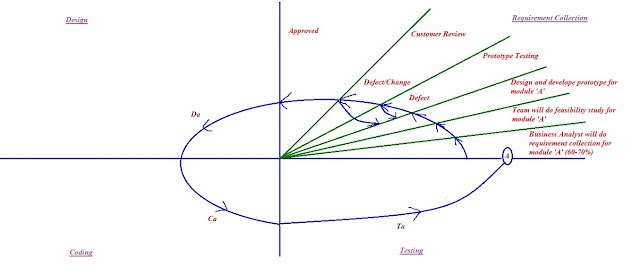Hybrid Model/Sandwich Model
Description
The process of combining or merging more than one model into a single model is called Hybrid Model.
Eg1: Spiral & Prototype Model
Explanation
- Customer gives requirement for module 'A'(60-70% requirement).
- Business Analyst will do requirement collection for module 'A'.
- Team will do Feasibility study for module 'A'.
- Web Designer or Developer will design prototype for module 'A'.
- Test Engineer will do prototype testing for module 'A'.
- If test Engineer find any defect in prototype then he will communicate with developer.
- Developer will fix the defect and give a new prototype.
- Test Engineer will again do prototype testing for new prototype.
- Once prototype testing is completed prototype will be send for customer review.
- If customer find any defect or he want to change something then he will communicate change/defect to developer.
- Developer will again fix the defect/change and give new prototype to test engineer.
- Test Engineer will do prototype testing for new prototype.
- Once prototype testing is completed prototype will be send for customer review again.
- If customer approved the prototype then architecture will do actual design for module 'A'.
- Developer will do actual coding for module 'A'.
- Test Engineer will do actual testing for module 'A'.
- Once testing is completed software quality is good module 'A' will be released to the customer.
For what kind of project we can go for prototype and spiral hybrid model
- When customer is new to business.
- When customer is not aware of complete requirement.
- When there is dependency between modules.
- When customer give requirement in stages.
Eg2: V&V & Prototype Model
Explanation
- Customer give requirement (60-70%) in form of CRS.
- Business Analyst will collect requirement.
- Explain it to project manager. Project Manager will take CRS and send it to developer and test engineer.
- Test Engineer will review CRS, write acceptance test plan and test case.
- Parallely developer will be converting CRS in to SRS and also design and develop the prototype.
- Once both test engineer and developer complete the work, SRS and prototype will be ready.
- Project Manager will take up SRS and Prototype and send it to both test engineer and developer.
- Test Engineer will do prototype testing.
- if there are no defect in prototype developer will start converting SRS to HLD parallely test engineer will review SRS against CRS and write system test plan and test case.
- Once both developer and test engineer completes the work HLD will be ready.
- Project Manager will take HLD and give it to test engineer.
- Test Engineer will review HLD against SRS parallely developer will start converting HLD to LLD.
- Once both developer and test engineer completes the work LLD will be ready.
- Project Manager will take LLD and give it to test engineer.
- Test Engineer will review LLD against HLD parallely developer will do actual coding.
- Once both developer and test engineer completes the work software will be ready.
- Project Manager will take software and give it to test engineer.
- Test Engineer will start with actual testing.
- Once testing is complete software quality is good software will be released to customer.
For what kind of project we go for v&v and prototype hybrid model ?
- For complex project.
- For long term project.
- When customer is new to business.
- When customer is not aware of complete requirement.



ConversionConversion EmoticonEmoticon